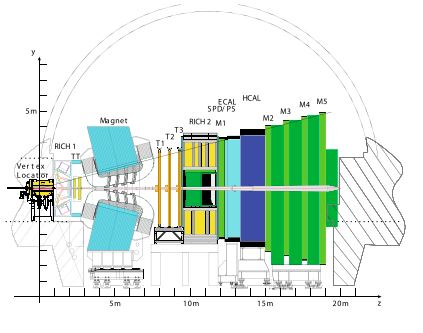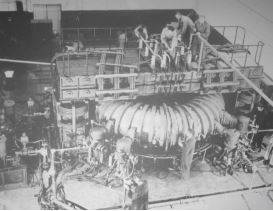News
EPJD Colloquium - Challenges and opportunities in verification and validation of low temperature plasma simulations and experiments
- Details
- Published on 21 May 2021

In the field of plasma physics, simulations are becoming increasingly relied upon to elucidate fundamental plasma phenomena as well as to simulate real-world plasma reactors. This new colloquium published in EPJD provides a description of how one research group (at Sandia National Laboratories) incorporates verification and validation (V&V) processes in their low temperature plasma (LTP) research and development activities.
EPJ Plus Highlight - Understanding the mechanism that gives light a ‘little extra push’
- Details
- Published on 07 May 2021

The use of light to move matter has a wide range of technological applications and could one day even power spaceflight. New research suggests a method to better understand this subtle phenomenon.
We are all familiar with the sight of a white pool ball striking a red and smoothly transferring its momentum. What is less familiar is that light can also transfer momentum and is even able to give objects a tiny push. A new paper published in EPJ Plus suggests a way to examine the mechanism behind light’s subtle momentum transfer — the Poynting vector. The paper is the work of Manuel Marqués of IFIMAC-The Condensed Matter Physics Center, and the Nicolás Cabrera Institute (INC), Universidad Autónoma de Madrid, Spain, and Shulamit Edelstein and Pedro Serena from the Spanish National Research Council (CSIC).
EPJ Plus Highlight - A deeper understanding of how cells move and stick together
- Details
- Published on 06 May 2021

The way cells adhere to surfaces is an important element in allowing them to form cohesive tissues. A new study looks at how cells stick to a surface and spread across it.
Observing how cells stick to surfaces and their motility is vitally important in the study of tissue maintenance, wound healing and even understanding how cancers progress. A new paper published in EPJ Plus, by Raj Kumar Sadhu, Weizmann Institute of Science, Rehovot, Israel, takes a step towards a deeper understanding of these processes.
EPJ H Highlight - Investigating heavy quark physics with the LHCb experiment
- Details
- Published on 15 April 2021

In ten years of operation the LHCb experiment has probed the nature of physics attempting to answer some of the Universe’s most fundamental questions. A new review examines its past achievements and future potential.
A new review published in EPJ H by Clara Matteuzzi, Research Director at the National Institute for Nuclear Physics (INFN) and former tenured professor at the University of Milan, and her colleagues, examines almost three decades of the LHCb experiment – from its conception to operation at the Large Hadron Collider (LHC) – documenting its achievements and future potential.
EPJ H Highlight - Tracking the progress of fusion power through 60 years of neutral particle analysis
- Details
- Published on 14 April 2021

Harnessing the fusion power of the stars requires the control of plasma and a powerful diagnostic tool to analyse it
As the world’s energy demands grow, so too does growing concern over the environmental impact of power production. The need for a safe, clean, and reliable energy source has never been clearer. Fusion power could fulfil such a need. A review paper published in EPJ H examines the 6-decade history of neutral particle analysis (NPA), developed in Ioffe Institute, Saint Petersburg, Russia, a vital diagnostic tool used in magnetic plasma confinement devices such as tokamaks that will house the nuclear fusion process and generate the clean energy of the future.
EPJ E Highlight - Micro-environmental influences on artificial micromotors
- Details
- Published on 31 March 2021

New experiments reveal the characteristic ways in which self-propelled ‘Janus particles’ with charged coatings will slide across or move away from charged boundaries in their surrounding environments.
By harvesting energy from their surrounding environments, particles named ‘artificial micromotors’ can propel themselves in specific directions when placed in aqueous solutions. In current research, a popular choice of micromotor is the spherical ‘Janus particle’ – featuring two distinct sides with different physical properties. Until now, however, few studies have explored how these particles interact with other objects in their surrounding microenvironments. In an experiment detailed in EPJ E, researchers in Germany and The Netherlands, led by Larysa Baraban at Helmholtz-Zentrum Dresden-Rossendorf, show for the first time how the velocities of Janus particles relate to the physical properties of nearby barriers.
EPJ Data Science Highlight - A data-driven approach for assessing biking safety in cities
- Details
- Published on 25 March 2021

The bicycle is arguably the most sustainable and eco-friendly mode of transport but biking safety remains a prime concern, especially in cities. In their work recently published in EPJ Data Science Konstantinos Pelechrinis and his co-authors propose a model which provides interpretable findings for practical change.
Continue reading the blog post here.
EPJ D Colloquium - All-atom relativistic molecular dynamics simulations of channeling and radiation processes in oriented crystals
- Details
- Published on 24 March 2021
In a new Colloquium article published in EPJD, authors from the MBN Research Center (Frankfurt am Main, Germany) review achievements made recently in the field of numerical modeling of ultra-relativistic projectiles propagation in oriented crystals, radiation emission and related phenomena. This topic is highly relevant to the problem of designing novel gamma-ray light sources (LSs) based on the exposure of oriented crystals to the beams of charged particles. Crystal-based LSs can generate radiation in the photon energy range where the technologies based on the fields of permanent magnets become inefficient or incapable.
EPJ H Highlight - Effective Field Theories and the Nature of the Universe
- Details
- Published on 23 March 2021

© Larry D. Moore CC BY-SA 3.0 https://commons.wikimedia.org/wiki/ File:Steven_weinberg_2010.jpg
Effective Field Theories were introduced to simplify the mathematics involved in unifying interactions into the Standard Model of particle physics. An article in EPJ H presents Nobel Laureate Steven Weinberg’s recent lecture on the development of these theories.
What is the world made of? This question, which goes back millennia, was revisited by theoretical physicist Steven Weinberg from the University of Texas in Austin, TX, USA in the first of an international seminar series, ‘All Things EFT’. Weinberg’s seminar has now been published as an article in the journal EPJ H.
EPJ B Colloquium - Particles, conformal invariance and criticality in pure and disordered systems
- Details
- Published on 23 March 2021

The two-dimensional case occupies a special position in the theory of critical phenomena due to the exact results provided by lattice solutions and, directly in the continuum, by the infinite-dimensional character of the conformal algebra. However, some sectors of the theory, and most notably criticality in systems with quenched disorder and short range interactions, have appeared out of reach of exact methods and lacked the insight coming from analytical solutions.




